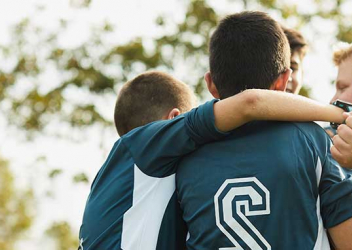Quantitative Assessments for
Sports-Related Concussion
An Institute of Medicine report on sports-related concussions in youth revealed how little is known about concussion in the young brain. This report also called for urgent attention to determine:
- the incidence of sports-related concussions (SRCs) in youths by sport and demographic
- research to identify an unbiased, sensitive prognostic and diagnostic metric and marker
- longitudinal studies to determine outcomes and to delineate age- and sex-related biomechanical determinants of injury risk
Objective Translational Multi-Domain Early Concussion Assessment Study
Study Objectives
This research project, funded by the National Institutes of Health (National Institute of Neurological Diseases and Stroke), focused specifically on developing a suite of quantitative assessment tools to enhance accuracy of sports-related concussion diagnoses, including eye-tracking, pupillometry and measures of cerebral blood flow. The study also determined sports settings with the highest impact exposures. It also integrated across animal (porcine) and human studies to relate rapid head rotation magnitude and direction to short-term outcomes.
These data provided prognoses of time-to-recovery and safe return-to-play for youth athletes. Researchers also examined sex-specific data to see how prevention and diagnosis strategies need to be tailored for males and females.
Investigational Plan
Over the course of the 5-year study, researchers at CIRP and the Injury Biomechanics Lab at the Georgia Institute of Technology pursued the following aims:
Aim 1 -- An unbiased numerical assessment suite for SRC was developed and validated. Objective metrics included assessments of balance, oculomotor function, visual and auditory processing, and sleep. Researchers determined if these metrics, or certain combinations of these metrics, identified the presence of SRC with high sensitivity and specificity and were predictive of days-to-clearance for sports. The research team then validated the findings in a separate cohort.
- Minds Matter researchers have published extensively on evaluations of visio-vestibular markers for concussion. As of June 2023, the CHOP Viso-Vestibular Exam was recommended to be part of the Child Concussion Office Assessment Tool (Child-SCOAT).
- In a 2019, study, published in Medicine & Science in Sports & Exercise, researchers found that a device-based measure of balance did not produce better discriminatory ability than two clinical assessments. One assessment, the complex tandem gait, had the additional benefit of being an easy-to-perform and graded test with highly sensitive and specific individual components.
- Another study published in 2023 examined how to maximize the accuracy of adolescent concussion diagnosis using individual elements of common standardized clinical assessment tools.
Aim 2 – Since the Aim 1 objective metrics were nonverbal and effort-independent, Minds Matter researchers "translated” their use to an animal model of traumatic brain injury (TBI), where human-like measures of physical, cognitive, and sleep deficits were associated with SRC in piglets after rapid controlled head rotations. Using this juvenile porcine TBI model, they determined SRC mechanisms by relating the influence of sex and load frequency, magnitude and direction on neuro-function, biomarkers and neuropathology. Both single rapid head rotations were studied, as well as a multiple sub-concussive rotations. By developing new technologies to translate human outcome metrics to animals, the Minds Matter team provided a human-like platform to develop and test injury treatments in the future.
- A Systematic Approach to Utilize Multiple Biomarkers
- Pupillary Light Response Deficits in 4-Week-Old Piglets and Adolescent Children after Low-Velocity Head Rotations and Sports-Related Concussions
- Read more about the Head Injury Research Lab at the Georgia Institute of Technology.
Aim 3 – The insights from Aim 2 were translated from animals to teens, where head impact sensors were used to quantify biomechanical load exposure by sport and sex, and relationships between load exposure and neuro-functional metrics using the numerical assessment suite developed in Aim 1. This provided new knowledge regarding high-risk biomechanical settings for the young brain:
- In a 2020 study, Video Confirmation of Head Impact Sensor Data From High School Soccer Players, researchers collected in vivo head impact biomechanics data on youth athletes, where their athletes were already wearing Triax SIM-G headband-mounted impact sensors during sports competition. Researchers found that head impact sensors could record a large number of false positive impacts during real game play in high school competitive soccer games. The extra step to video-confirm the sensor data was essential to minimize false positives before using this data.
Of note, the study is using BOTH male and female high school athletes and piglets in a deliberately parallel study design to determine optimal SRC assessments and identify mechanistic relationships between sex, energy loading conditions, and SRC symptoms.
Watch how Dr. Declan Patton uses instrumented mouth guards to measure head impacts of high school athletes in his research:









